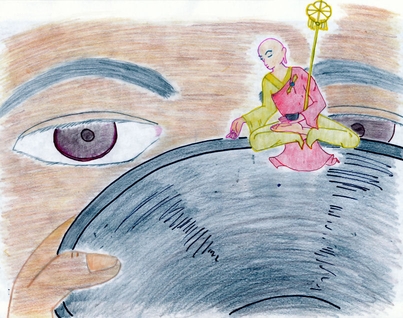
“On the rim of the begging bowl there sits a little moth that looks just like a miniature bhikshu.”
(Drawing by Kimberly N. Chau, Earl Warren College, UCSD, Class of 2018, by permission.)
Mùlián 目连 (Maudagalyāyana) = A disciple of the Shakyamuni Buddha, known for spiritual precocity
Another Buddha in a far-off world
Various Buddhist disciples (bhikshus)
Once upon a time, Mùlián 目连, the greatest in spiritual ability among all the disciples of the Buddha, said to the other disciples: “Wherever we go, we hear the voice of the Buddha as though we were beside him. By magic I shall travel afar off to learn the true loudness of his voice.” And saying this, he flew away from our universe and traversed countless other worlds, but still he heard the voice of the Buddha, as though right beside him.
Finally Mùlián grew tired and descended to earth, where he landed in the world of a different buddha just as that buddha’s disciples were seated to receive alms. All of them were enormous, while Mùlián himself seemed no larger than a bug. He settled on the rim of their rice bowl to rest, and there the disciples discovered him.
“On the rim of the begging bowl there sits a little moth that looks just like a miniature bhikshu,” they said. “Where would such a bhikshu-bug have come from?”

Their buddha, the savior of their world, saw all this and told them: “Because you are ignorant, you have misunderstood what you are looking at. What is on the rim of the begging bowl is not an insect. East of here, across countless buddha-worlds there is world called Sahā (‘innate’). The Shakyamuni Buddha appeared there, and this is his disciple Mùlián, who is the one among their number with the greatest spiritual ability. Everywhere he hears the voice of his buddha equally loudly. To explore its loudness, he has flown across countless worlds and has finally arrived in ours.”
When they had heard this, the disciples rejoiced, as did Mùlián himself before returning to his own world. There, because of the miracle of the Buddha’s voice, he worshiped the Buddha ever more devotedly.
Or so we are told.
The preceding tale is from a Japanese collection of 1059 tales of popular lore called Konjaku Monogatari-shū (今昔物語集 (“Once-Upon-a-Time Stories”). The stories are set in India, China, and Japan and were assembled in 31 volumes in the early XIIth century, during Japan’s Heian period. The story here is retold based on an Esperanto translation by SIMATANI Takesi ( 島谷剛) 2015 今昔物語集: Rakontoj Antaŭ Longa Tempo. Osaka: Japana Esperanto Librokooperativo. This is story 3, from volume 3, retold here from Simatani pp. 4-5.